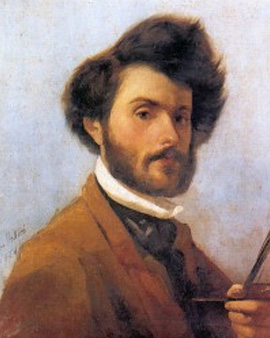


Different times, different customs: in the middle of the 19th century, when war was still seen as a legitimate "continuation of politics by other means", an artist's career could start by winning a competition for a battle painting. Giovanni Fattori achieved this in 1861 with the "Battlefield of Magenta", which celebrates the victory of Piedmont-Sardinia over the Austrians in 1895. A few years later the Kingdom of Piedmont-Sardinia was the driving force behind the "Risorgimento", the unification of Italy as one nation. Fattori's painting hangs today in the "Galleria d'Arte moderne" in Florence.
Giovanni Fattori was born in Livorno, where he was also trained as a painter by Giuseppe Baldini before studying in Florence at the "Accademia di belli Arti". Fattori generally had a non-conformist streak: in 1848/49 he took part in the independence movement that wanted to liberate Veneto from Austrian rule. As an artist, he was co-founder of a movement that turned away from the "academic" style of painting and turned towards realism. Because of their preference for natural landscapes, these deviants were initially scornfully called "Macchiaioli", undergrowth painters, by the established. However, this soon became a concept of quality that the group proudly adopted.
It is no accident that Camille Corot and Édouard Manet were his declared role models. His speciality were landscape paintings, preferably rural scenes, and his later battle scenes also turned out to be very real, such as "The fallen horseman" or "Mary Stuart at Crookston", which deals with the capture of the Scottish queen after a lost battle. Another of Fattori's specialities were "sketches", pictures on small wooden boards, preferably cigar-lid boxes. His paintings were never as colourful as the works of Impressionism, for example, but rather in delicate sepia, grey and brown tones.
Fattori dared to take the step from a purely academic to a realistic painting style, but remained attached to the classical style of painting and strictly rejected other "rebellious" styles of the time. Throughout his life he was an opponent of Impressionism and caused a great stir in 1891 when he sharply attacked the art movement of "Pointilism" (a painting style that used color theory to assemble picture compositions from small spots - the most famous representative was certainly Paul Signac) in a polymite manner. Four years later Fattori, who had been teaching at his "Accademia di Bella Arti" since 1869, advanced to full professor: he taught landscape painting at the Alma Mater in Florence, where he had once studied himself. The last years of his life were overshadowed by the death of his second wife, as well as by disappointment over the social development in unified Italy on the one hand and the "betrayal" of some of his students who turned to post-impressionism and pointilism on the other. Fattori died in 1908 at the age of 83.

Different times, different customs: in the middle of the 19th century, when war was still seen as a legitimate "continuation of politics by other means", an artist's career could start by winning a competition for a battle painting. Giovanni Fattori achieved this in 1861 with the "Battlefield of Magenta", which celebrates the victory of Piedmont-Sardinia over the Austrians in 1895. A few years later the Kingdom of Piedmont-Sardinia was the driving force behind the "Risorgimento", the unification of Italy as one nation. Fattori's painting hangs today in the "Galleria d'Arte moderne" in Florence.
Giovanni Fattori was born in Livorno, where he was also trained as a painter by Giuseppe Baldini before studying in Florence at the "Accademia di belli Arti". Fattori generally had a non-conformist streak: in 1848/49 he took part in the independence movement that wanted to liberate Veneto from Austrian rule. As an artist, he was co-founder of a movement that turned away from the "academic" style of painting and turned towards realism. Because of their preference for natural landscapes, these deviants were initially scornfully called "Macchiaioli", undergrowth painters, by the established. However, this soon became a concept of quality that the group proudly adopted.
It is no accident that Camille Corot and Édouard Manet were his declared role models. His speciality were landscape paintings, preferably rural scenes, and his later battle scenes also turned out to be very real, such as "The fallen horseman" or "Mary Stuart at Crookston", which deals with the capture of the Scottish queen after a lost battle. Another of Fattori's specialities were "sketches", pictures on small wooden boards, preferably cigar-lid boxes. His paintings were never as colourful as the works of Impressionism, for example, but rather in delicate sepia, grey and brown tones.
Fattori dared to take the step from a purely academic to a realistic painting style, but remained attached to the classical style of painting and strictly rejected other "rebellious" styles of the time. Throughout his life he was an opponent of Impressionism and caused a great stir in 1891 when he sharply attacked the art movement of "Pointilism" (a painting style that used color theory to assemble picture compositions from small spots - the most famous representative was certainly Paul Signac) in a polymite manner. Four years later Fattori, who had been teaching at his "Accademia di Bella Arti" since 1869, advanced to full professor: he taught landscape painting at the Alma Mater in Florence, where he had once studied himself. The last years of his life were overshadowed by the death of his second wife, as well as by disappointment over the social development in unified Italy on the one hand and the "betrayal" of some of his students who turned to post-impressionism and pointilism on the other. Fattori died in 1908 at the age of 83.
Page 1 / 3






